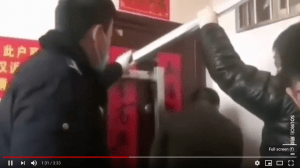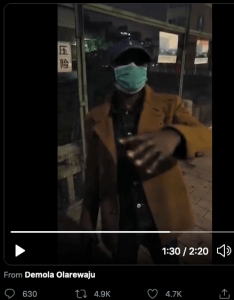The Teach311.org + COVID-19 collective and the History of Science ON CALL project are pleased to co-present this Note from the Field from historian Angela Ki Che Leung about the role of the humanities in understanding and dealing with the current pandemic. We are grateful for this history of medicine insight that maps out different levels in which blatant stigmatization have been produced during the pandemic. This map will be essential for scholars, students, and the general public wishing to do their part to dismantle stigmatization. Leung is Director and Chair Professor of History at The University of Hong Kong. – Editors
As a historian who had studied the history of leprosy, I was not surprised when the first cases of stigmatization appeared in the current coronavirus pandemic. I have learned from my past research that when a society has to cope with the uncertainty and fear of an unfamiliar, deadly epidemic, it easily resorts to victimizing certain social groups as “others,” labelling them as contaminators, ostracizing them to keep society pure. People of a particular race, class, place, gender, sexual orientation are often seen as the others and accused of being the disease carriers, because of their perceived inferior biological or moral quality. Chinese migrant laborers were stigmatized in the leprosy pandemic in the early twentieth century in very much the same way as male homosexuals were in the AIDS epidemic towards the end of that century.
What is unique about the stigmatization process of the current coronavirus disaster is that the unprecedented scope, complexity and impact of the pandemic generate multiple layers and levels of victimization at different stages of its twist and turn. Following this process allows us to see more clearly fissures in the existing social, political and economic structures of affected communities, local and global. Such cracks have been invisible in times of normalcy.
Let us first follow the process chronologically, beginning at the outbreak in Wuhan in late January. We first saw the stigmatization of people traveling from Wuhan and Hubei province on a national level. They were quickly ostracized when Wuhan was about to be shut down. People returning to their native place from Wuhan and Hubei province for the Chinese New Year were not allowed to go home, or were forcefully confined in their home. Access to villages was blocked; villagers sometimes cordoned off homes of returnees with banners indicating their identity as Wuhan returnees, warning villagers to avoid them, or simply nailed shut their doors (photo 1). On the other hand, Wuhan migrant workers in other provinces were not allowed to return to their rented apartments, as in the case of a village in Guangdong province where the village committee together with landlords issued an order prohibiting people from Hubei to rent in the village. The idea of living near people of Wuhan or Hubei origin became a terrifying one.

With the lifting of Wuhan’s lockdown in early April, when all survivors of the virus were cured, painful stories about rejection of healed patients by their own family and neighbours are emerging. Many ex-patients suddenly found out that, after having survived agonizing therapeutic treatments in the hospital, they were not welcome back to their family or community. Often they were made to understand that they were still contaminators, and their presence was not welcome at home nor in public. One of them saw a neighbour spit on her window, and another found a sticker on his door one day, with a phrase encircled in a pink heart, “Family deeply concerned with the prevention of pneumonia.” Some thus chose to confine themselves in their room to avoid scornful gazes and scathing remarks from people who had been acquaintances. Some simply stopped communicating with people.
Two former patients tried to understand and explain their situation: “Even though I am cured, people still avoid me like a virus…Friends sent me the news of a cured patient who died after becoming positive again. Their reminder makes me feel terrible. I am segregated by a society that I once loved. No one socializes with me. People do not hide their rejection by words and action… They think that we are dangerous, that our healthy state is only temporary.” “Now the whole country stigmatizes Hubei people, Hubei people stigmatize Wuhan people, Wuhan people stigmatize the sick, the ordinary sick stigmatize those sickened by the coronavirus. We are at the bottom of the chain of stigmatization. Even though we are cured, we are still considered unclean virus carriers that society should not accept.” The fate of these patients, rejected by their own as nothing more than the embodiment of the virus, is strikingly similar to that of victims of leprosy more than a century ago.
Let us now turn to stigmatization on a global level, which is essentially racial in nature. Asians in general were victimized as soon as the pandemic was reaching the West, as shown by cases of violent attack on Asians in early February, especially those wearing face masks on the street in Western cities, particularly in the US and Australia. African traders in China, on the other hand, were victimized as a racial group when the second wave of the pandemic emerged in early April with imported cases from people returning to work. Africans in Canton, where a big worker community had formed in the past twenty years, were soon stigmatized as virus carriers even though at that time only one tenth of confirmed cases were Africans. Many were evicted from their homes and turned away by hotels, some with their passports seized and were forced to take tests and be quarantined even if they had been proven negative (photo 2). Attacks in social media on the African community, demanding their deportation also turned violent. The events have provoked a diplomatic crisis, still on-going, with a formal protest signed by several African ambassadors addressed to the Chinese government.

As the pandemic is still in progress, so is the stigmatization process. It has already revealed fragile points in the existing social, economic, political, and cultural systems on local, national and global levels. Some of the social fabrics that people have taken for granted—family, neighbourhood, community—disintegrated more quickly than others under the threat of the virus. So did deceptively healthy bilateral trade and diplomatic relations. We shall certainly continue to witness more stigmatization and conflicts that reveal and magnify distrust, prejudices, inequality and division on various levels. Such schisms feed on ignorance, self-interest and distortion of medical science. The pandemic is a shrewd tester to check the working of our system. It is the responsibility for all citizens of the world to mend the glaring cracks now fully brought to light by blatant stigmatization.
Angela Ki Che Leung is Director and Chair Professor of History at The University of Hong Kong and Joseph Needham-Philip Mao Professor in Chinese History, Science & Civilization. She joined the Hong Kong Institute for the Humanities and Social Sciences in January 2011 as its first full-time director. Her present research focus is on food technology in modern China. Her broader interests are on the history and social science study on science, medicine and technology in pre-modern and modern East Asia. Her recent publications include Leprosy in China: A History (Columbia University Press, 2009), Health and Hygiene in East Asia: Policies and Publics in the Long Twentieth Century (co-edited with Charlotte Furth) (Duke University Press, 2010), and Gender, Health, and History in Modern East Asia (Co-edited with Izumi Nakayama) (Hong Kong University Press, 2017), Moral Foods: The Construction of Nutrition and Health in Modern Asia (co-edited with Melissa L. Caldwell) (University of Hawai’i Press, 2019). Leung is also leading a collaborative project on everyday technologies in the making of modern East Asia. Click here to read more.
* * *
The Teach311 + COVID-19 Collective began in 2011 as a joint project of the Forum for the History of Science in Asia and the Society for the History of Technology Asia Network and is currently expanded in collaboration with the Max Planck Institute for the History of Science(Artifacts, Action, Knowledge) and Nanyang Technological University-Singapore.
![[Teach311 + COVID-19] Collective](https://blogs.ntu.edu.sg/teach311/files/2020/04/Banner.jpg)